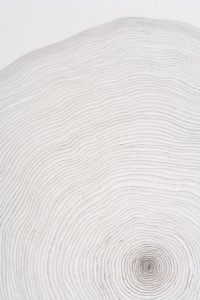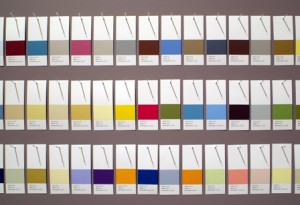Collaboration is the new black these days, as diverse individuals and departments at a variety of educational institutions come together on issues of climate change. The results are innovative, striking, surprising, and even…artistic.

“We’re coming at scepticism sideways,” says Daulton. “Our society tends to see art and science as diametrically opposed but I actually see them as part of a continuum. What artist isn’t inspired by some part of the world as we know it? What scientist doesn’t love and gain inspiration from the topic he/she is exploring? Good science is artistic.”

Another marriage of climate change and art, organized by the Smart Museum at the University of Chicago, represents the members of the community it’s in with an exhibit titled Beyond Green: Toward a Sustainable Art. Chicago artist Kevin Kaempf collects leftover paint cans from the garages and basements of people in the community, then mixes them to create new colors, which he packages in his own “Loop” brand paint cans. (Loop is the title of the piece.) Some of the paint is used to create a site-specific painting at each exhibition site, along with a group of paint swatches from each color of donated paint-representing the people in the communities who have joined together to create the new hues. The focus on reuse, as well as the work’s specificity to its region, is what makes the art about sustainability.
In another contribution to the show, the artist group WochenKlausur addresses the inherent wastefulness in traveling art exhibits by creating a system to network art institutions and help them upcycle used materials. The group also developed prototype furniture from discarded materials that travels with Beyond Green for people to sit on while they visit the exhibit.
Since its inception in 2005, Beyond Green has toured campuses at California State University Long Beach, Smith College, DePauw University, University of Hartford, Lewis & Clark College, and Northern Michigan University. (It is still on tour: to learn more about Beyond Green, you can download the podcast or read the catalog online.)
Last but not least, a multi-dimensional exhibit entitled Climate Change at the Poles was organized at the University of Kansas Spencer Museum of Art in conjunction with the current International Polar Year. Public programs accompanying Climate Change at the Poles include a sustainable art class for children; a performance of the Inuit legend The Ice Wolf; a book and film series; a cross-disciplinary panel on perspectives on “Nature & Art,” including topics such as law, dance, journalism, and anthropology; and a multi-media event performed by DJ Spooky entitled Terra Nova: Sinfonia Antarctica.
Such exhibits can be both beautiful and alarming in their portrayals of rapidly changing ecosystems. Susan Sontag once said, “real art has the capacity to make us nervous.” The artists, who intend that audiences will walk away with a heightened desire to assume responsibility for their communities and environment, hope that she is right. If they are successful, such projects could indeed be the tip that saves the iceberg.


